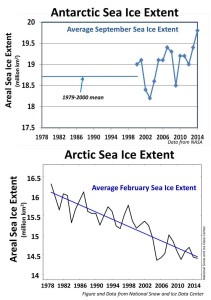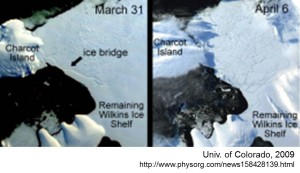Why Is Antarctic Sea Ice Growing?
Posted: March 4, 2015
Antarctic sea ice areal extent is indeed growing. Does that mean Antarctica is cooling? Nope. In what feels like a counter-intuitive statement, the ice is in fact growing because the glaciers are melting. That probably needs some explanation. Land glaciers in Western Antarctica are melting, and melt is accelerating in parts of the Western Antarctic Ice Sheet. Glaciers are formed of fresh water, so when they melt and that water flows into the sea, the salinity of the ocean at that site drops. Fresh water is less dense than sea water so it stays near the surface. Fresh water also freezes at a higher temperature than sea water. Sea water of typical salinity freezes at 28°F (-2°C). So the fresh water at the surface freezes at warmer temperatures than sea water, resulting in formation of more floating ice.
Measurements show, in fact, that both surface sea and atmosphere temperatures in Antarctic have warmed from 1979 to 2004 as reported by Zhang, 2007 in the Journal on Climate. That warming trend is continuing. The land glaciers are melting. NASA measurements show a significant decrease in mass of land glaciers since 2002. Ice shelves (ice attached to land ice extending as a floating “shelf” into the ocean) are collapsing in Western Antarctica. In 2002 the Rhode Island-sized Larsen B shelf along Eastern edge of Antarctic Peninsula collapsed.
In 2009 an ice bridge on the Wilkins Ice Shelf on the Western side of the Antarctic Peninsula collapsed. It took just three weeks for the 12,000-year old ice shelf to crumble. And because of the modified stresses on the ice sheet, the breakup is continuing.
Click on figure to enlarge.
Routine satellite measurements of ice extent began in 1979, and since that time Antarctic sea ice has grown by about 1 percent per decade.  Meanwhile, the Arctic sea ice extent has been decreasing, as shown on the figure to the left. These two figures are for the same time period and approximately the same scale so they can be compared. The different trends are apparent. Arctic ice is in an ocean surrounded by land. Antarctica is land surrounded by ocean. Since there is no land ice to decrease salinity around the Arctic ocean, ice extent is controlled primarily by warming and is decreasing.
Meanwhile, the Arctic sea ice extent has been decreasing, as shown on the figure to the left. These two figures are for the same time period and approximately the same scale so they can be compared. The different trends are apparent. Arctic ice is in an ocean surrounded by land. Antarctica is land surrounded by ocean. Since there is no land ice to decrease salinity around the Arctic ocean, ice extent is controlled primarily by warming and is decreasing.
Weird as it sounds, Antarctic sea ice is growing because the land glaciers (ice sheets) are melting.
Click on figure to enlarge.


No one has left a comment yet.